|
|
|
| Theory of Relativity 4u |  |
||||
 |
|||||
| Home Page 4u |
|
||||
 |
|||||
Relativity can be described using space-time diagrams.
Contrary to popular opinion, Einstein did not
invent relativity. Galileo preceded him.
Aristotle
had proposed that moving objects (on the Earth) had a natural tendency to slow
down and stop. This is shown in the space-time diagram below.
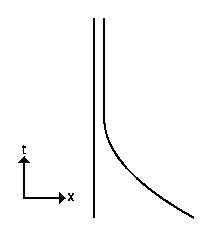
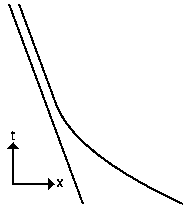
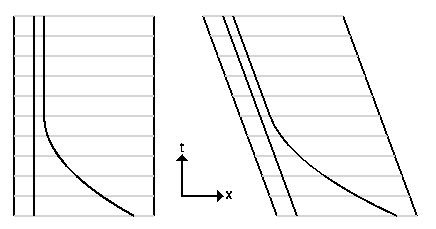
But Galilean transformations do not preserve velocity. Thus the statement "The speed limit is 70 mph" does not make sense -- but don't try this in court. According to relativity, this must be re-expressed as "The magnitude of the relative velocity between your car and the pavement must be less than 70 mph". Relative velocities are OK.
But 200 years after Newton the theory of electromagnetism was developed into
Maxwell's
equations. These equations describe waves with a speed of
1/sqrt(epsilono*muo), where epsilono is the
constant describing the strength of the electrostatic force in a vacuum, and
muo is the constant describing the strength of the magnetic
interaction in a vacuum. This is an absolute velocity -- it is not relative to
anything. The value of the velocity was very close to the measured speed of
light, and when Hertz generated electromagnetic waves (microwaves) in his
laboratory and showed that they could be reflected and refracted just like
light, it became clear that light was just an example of electromagnetic
radiation. Einstein tried to fit the idea of an absolute speed of light into
Newtonian mechanics. He found that the transformation from one reference frame
to another had to affect the time -- the idea of sliding a deck of cards had to
be abandoned. This led to the theory of special relativity. In special
relativity, the velocity of light is special. Anything moving at the speed of
light in one reference frame will move at the speed of light in all
unaccelerated reference frames. Other velocities are not preserved, so you can
still try to get lucky on speeding tickets.
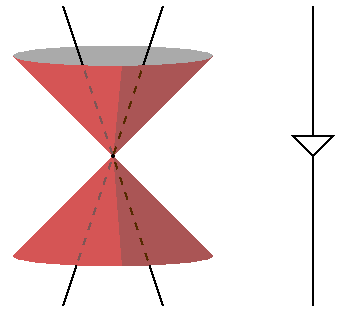
Thus in the situation shown in 3 space-time diagrams below, the central
section shows the worldline of one stationary observer, one observer moving to
the right, and two events on the future light cone on the event where the two
observers' worldlines cross.

What is the evidence for the invariance of the speed of light? The hypothesis
that the speed of light is c relative to its source can easily be disproved by
the one-way transmission of light from distant supernovae. When a star explodes
as a supernova, we see light coming from material with a large range of
velocities dv, at least 10,000 km/sec. Because of this range of velocities, the
spectral lines of a supernova are very broad due to the Doppler shift. After
traveling a distance D in time D/c, the arrival time of the light would be
spread out by dt = (dv/c)(D/c).
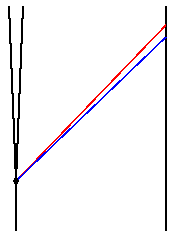
However, light could travel at speed c relative to a medium -- the ether. If
it did, then the rate of a "bouncing photon clock" moving with respect to the
ether
P(par) = L/(c-v) + L/(c+v) = [2L/c]/(1-v2/c2).If the clock is moving perpendicular to its axis, the light has to move a distance L sideways and a distance vt "upstream" to keep up with the clock, where t is the one-way time. The total distance traveled is ct, which is the hypotenuse of a right triangle with sides L and vt. Thus the period is given by:
(ct)2 = L2 + (vt)2 so t = L/sqrt(c2-v2) P(perp) = 2t = [2L/c]/sqrt(1-v2/c2).Thus the ether model predicts that
dP/P = [P(par)-P(perp)]/P = 0.5*v2/c2.Brillet and Hall (1979, PRL, 42, 549) actually built a bouncing photon clock (a laser stabilized to a Fabry-Perot etalon) on a rotating table and compared its rate to an atomic clock (a laser stabilized to a methane line).
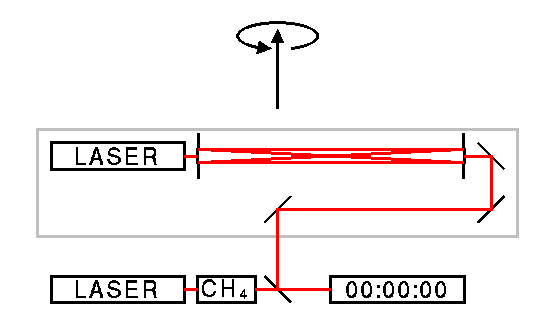
Michelson and Morley used two bouncing photon clocks at right angles to each other, but without the lasers and counters which didn't exist. This left an L-shaped interferometer. But they were able to show that dP/P was essentially zero instead of the ether model prediction.
The constancy of the speed of light allows the use of radar (RAdio
Detection And Ranging) to measure the position and time of events not on an
observer's worldline. All that we need are a clock and the ability to emit and
detect radar pulses.
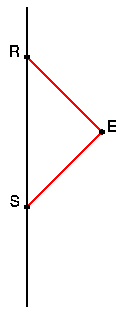
Armed with radar, we can determine the time of two events on the worldline of
an observer moving with respect to us. We can then compare the time interval we
measure to the time interval to the time interval measured by the moving
observer. Consider the two observers A and B below.

v = D/t = DA(R)/tA(R) = c(k*k-1)/(k*k+1).We can solve for k giving
k = sqrt((1+v/c)/(1-v/c))which is the relativistic Doppler shift formula. But we also find that tA(R) > tB(R), so A says that B's clock is running slow. The amount of this time dilation is
(1+k*k)/(2*k) = 1/sqrt(1-v2/c2).Thus moving clocks run slow. Note that B will also find that A's clock is running more slowly than his. There is a symmetric disagreement about clock rates.
This slow down factor is exactly the slow down calculated above in the ether
model for a bouncing photon clock moving perpendicular to its bounce axis. The
clock moving parallel to the axis slows down by the same amount under special
relativity because of the Lorentz-Fitzgerald contraction of moving
objects in the direction of motion.
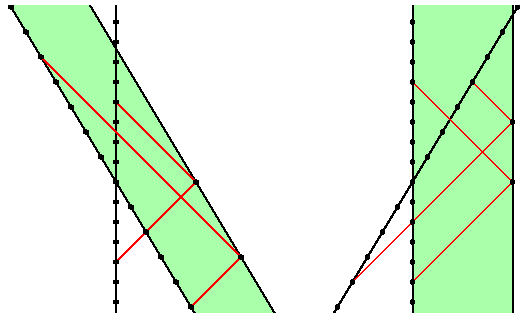
P(par) = [2L*sqrt(1-v2/c2)/c]/(1-v2/c2)
= [2L/c]/sqrt(1-v2/c2) = P(perp)
so the rate of a bouncing photon clock does not depend on the angle
between its velocity and its bouncing axis.
Because the clocks of different observers run at different rates, depending
on their velocities, the time for a given observer is a property of that
observer and his worldline. This time is called the proper time because
it is "owned" by a given particle, not because it is the "correct" time. Proper
time is invariant when changing reference frames because it is the property of a
particle, not of the reference frame or coordinate system. In general, given any
two events A and B with B inside the future light cone of A, there is one
unaccelerated worldline connecting A and B, just as there is one straight line
connecting two points in space. In the frame of reference of the observer
following this unaccelerated worldline, his clock is always stationary, while
clocks following any other worldline from A to B will be moving at least some of
the time. Because moving clocks run slow, these observers will measure a smaller
proper time between events A and B than the unaccelerated observer. Thus the straight worldline between two events has the largest proper
time, and all other curved worldlines connecting the two events have smaller
proper times. This is exactly analogous to the fact that the straight line
between two points has the smallest length of all possible curves between the
points. Thus the "twin paradox" is no more paradoxical than the statement that a
man who drives straight from LA to Las Vegas will cover fewer miles than a man
who drives from LA to Las Vegas via Reno. Now we come to a matter of gravity: how can gravity be an inverse square law
force, when the distance between two objects can not even be defined in
Einstein's special relativity? Special relativity was constructed to satisfy
Maxwell's equations, which replaced the inverse square law electrostatic force
by a set of equations describing the electromagnetic field. So gravity was the
only remaining action-at-a-distance inverse square law force. And gravity has a
unique property; the acceleration due to gravity at a given place and time is
independent of the nature of the body.
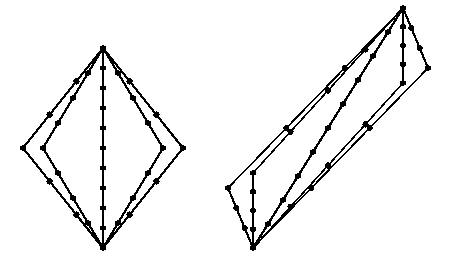
The pair of
space-time diagrams above show quintuplets separated at birth. The middle
worldline shows the quint who stays home. The space-time diagram on the left is
done from the point of view of the middle quint. Each dot on a worldline is a
birthday party, so the middle quint is 10 years old when they all rejoin each
other, while the other quints are 6 and 8 years old. The space-time diagram on
the right shows the same events from the point of view of an observer initially
moving with one of the moving quints. When the quints come together their ages
are still 6, 8, 10, 8, and 6 years. Thus the straight worldline between two
events can be found by maximizing the proper time, just as the straight line
between two points can be found by minimizing the length.
General Relativity
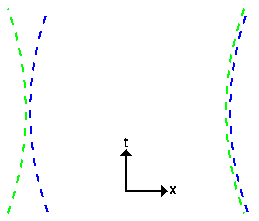
The
space-time diagram above shows a proton and an antiproton moving under the
influence of an electric field on the left and a gravitational field on the
right. Gravity accelerates all objects equally. This fact was known to Newton,
and tested to an accuracy of 1 part in 100 million by Eotvos. Later work by
Dicke and by Braginsky has improved the accuracy of the test to 1 part in a
trillion. A space mission called STEP has been proposed which will
test the equality of acceleration to 1 part per quintillion. In 2000 STEP was selected for further study
in NASA's SMEX program.
Thus through any event in space-time, in any given direction, there is only
one worldline corresponding to motion solely influenced by gravity. Compare this
to the geometric fact that through any point, in any given direction, there is
only one straight line. We are led to propose that worldlines influenced only by
gravity are really straight worldlines. But how can an accelerating body have a
straight worldline? It all depends on how you measure it. Suppose we plot a
straight line on polar graph paper, and then make a plot of radius vs angle as
shown below?
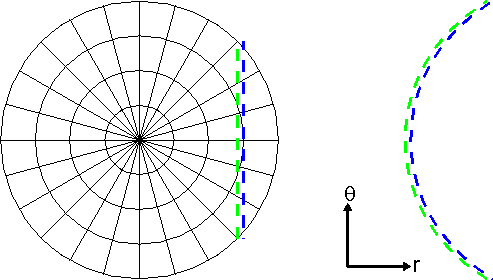
Einstein proposed that the effects of gravity (in a small region of
spacetime) are equivalent to the effect of using an accelerated frame of
reference without gravity. As as example, consider the famous "Einstein
elevator" thought experiment. If an elevator far out in space accelerates upward
at 10 meters/second2, it will feel like a downward acceleration of
gravity at 1 g = 10 m/s2. If a clock on the ceiling of the elevator
emits flashes of light f times per second, an observer on the floor will see
them arriving faster than f times per second because of the Doppler shift due to
the acceleration of the elevator during the light transit time.
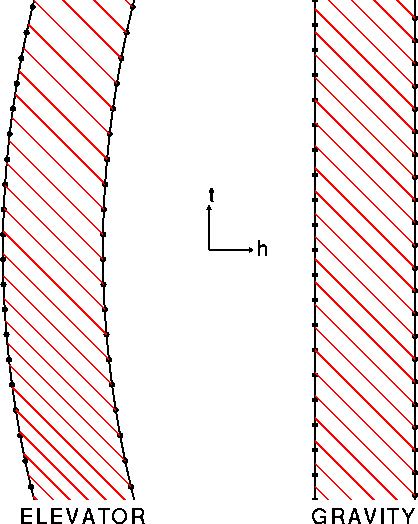
The effect of gravity on clocks was tested to greater precision by Vessot etal (1980, PRL, 45 2081) who launched a hydrogen maser straight up at 8.5 km/sec, and watched its frequency change as it coasted up to 10,000 km altitude and then fell back to Earth. The frequency shift due to gravity was (f'/f -1) = 4*10-10 at 10,000 km altitude, and the experimental result agreed to within 70 parts per million of this shift.
Because of the gravitational speedup for uphill clocks, an observer moving
between two events can achieve a larger proper time by shifting his worldline
upward in the middle. Going too far upward requires moving so fast that time
dilation due to motion reduces the proper time more than the gravitational
speedup, so there is an optimum curvature to the worldline that maximizes the
proper time.
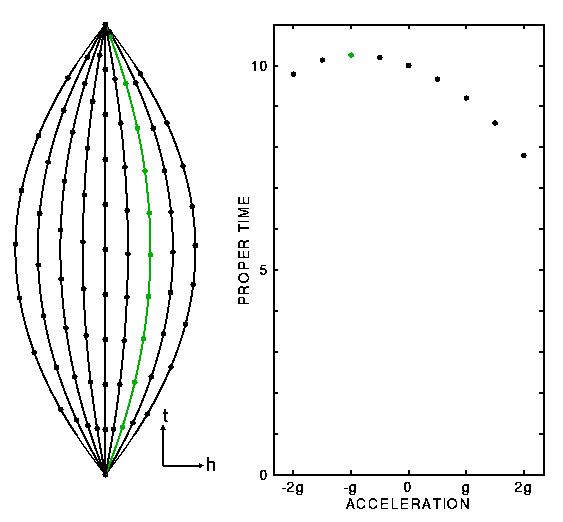
Curved coordinates alone, such as the polar graph, do not provide a
satisfactory model for gravity. Two straight lines through the same point but
with different directions will never cross again, while two worldlines
influenced only by gravity which pass through the same event with different
velocities can cross again. Consider the Galileo spacecraft, which made two
Earth flybys. In between the flybys, Galileo was on an elliptical orbit with a 2
year period. In order to allow "straight" lines to cross multiple times, a
curved space-time is needed. As a familiar example of a curved space, consider
the surface of the Earth and the great circle arc connecting two cities. The
great circle is the shortest distance between two points on the surface of the
Earth, and it is the path followed by airliners.
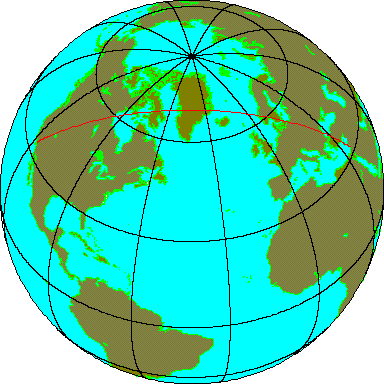
Plotting latitude vs longitude, as if longitude were time and latitude
position, gives the pseudo-spacetime diagram below.
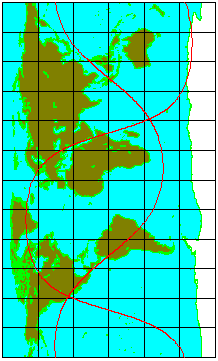
Thus the fundamentals of relativity that are important for cosmology are:
There are many books on relativity available, but two that stick to a simple level of mathematics are: